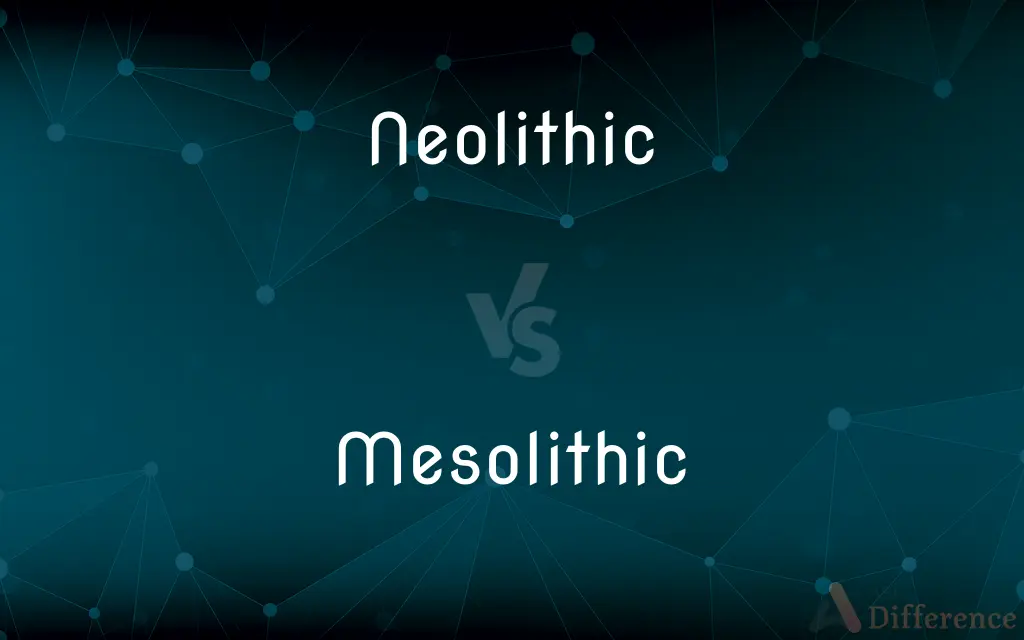Neolithic vs. Mesolithic — What's the Difference?
By Fiza Rafique & Urooj Arif — Updated on March 27, 2024
The Neolithic period marks the dawn of agriculture and sedentary life, while the Mesolithic era represents a transitional phase with increased hunter-gatherer sophistication.

Difference Between Neolithic and Mesolithic
Table of Contents
ADVERTISEMENT
Key Differences
The Neolithic era, also known as the New Stone Age, is characterized by the beginning of farming, animal domestication, and the establishment of permanent settlements. This period saw the development of agriculture as a primary means of subsistence, leading to significant changes in human society and lifestyle. On the other hand, the Mesolithic period, or Middle Stone Age, served as a bridge between the Paleolithic and Neolithic eras. It featured advancements in tool technology, a reliance on hunting and gathering, and the start of a more settled lifestyle in some areas.
During the Neolithic, communities began to construct durable houses and develop villages, indicating a shift towards permanent settlements. Whereas, in the Mesolithic era, people primarily lived in temporary shelters or seasonal camps, reflecting their hunter-gatherer lifestyle.
The invention and widespread use of pottery is a hallmark of the Neolithic period, showcasing advancements in art and storage techniques. On the other hand, the Mesolithic period is noted for its microliths—small, flint stone tools that were part of composite tools, highlighting a refinement in tool-making skills.
The Neolithic era witnessed the emergence of complex societies with social hierarchies and the division of labor, driven by agricultural surplus. In contrast, Mesolithic societies were generally smaller, more egalitarian groups that moved seasonally following food sources.
Agriculture in the Neolithic period led to population growth and the development of trade networks, as communities had surplus goods to exchange. Meanwhile, the Mesolithic era saw the beginning of such exchanges on a smaller scale, as groups traded goods and ideas over wider areas than in the Paleolithic.
ADVERTISEMENT
Comparison Chart
Main Subsistence
Agriculture
Hunting and gathering
Settlements
Permanent villages
Temporary or seasonal camps
Technological Innovations
Pottery, polished stone tools
Microliths
Social Structure
Complex societies with hierarchies
Smaller, egalitarian groups
Trade and Exchange
Development of trade networks
Beginning of trade on a smaller scale
Compare with Definitions
Neolithic
The period saw the construction of megaliths, large stone structures.
Stonehenge is a famous Neolithic structure.
Mesolithic
It bridges the gap between the Paleolithic and Neolithic periods.
Mesolithic artifacts reflect a transition in human toolmaking.
Neolithic
It is marked by the invention of pottery for storage and cooking.
Neolithic pottery fragments are found in ancient village sites.
Mesolithic
The era saw improvements in tool technology, such as microliths.
Microliths were crucial for Mesolithic hunters and gatherers.
Neolithic
The Neolithic era introduced agriculture, leading to permanent settlements.
The discovery of Neolithic farming tools indicates early agricultural practices.
Mesolithic
Mesolithic people practiced a semi-nomadic lifestyle.
Seasonal campsites show Mesolithic movement patterns.
Neolithic
Neolithic societies developed weaving and textiles.
Impressions of woven textiles have been found on Neolithic clay.
Mesolithic
There was an increase in artistic expression during the Mesolithic.
Cave paintings from the Mesolithic period depict complex scenes.
Neolithic
The era witnessed the beginning of metalworking.
Copper tools from the late Neolithic period show early metal use.
Mesolithic
The Mesolithic era is characterized by advanced hunting and gathering techniques.
Mesolithic people used microliths for efficient hunting.
Neolithic
The Neolithic period is the final division of the Stone Age, with a wide-ranging set of developments that appear to have arisen independently in several parts of the world. It is first seen about 12,000 years ago when the first developments of farming appeared in the Epipalaeolithic Near East, and later in other parts of the world.
Mesolithic
The Mesolithic (Greek: μέσος, mesos "middle"; λίθος, lithos "stone") is the Old World archaeological period between the Upper Paleolithic and the Neolithic. The term Epipaleolithic is often used synonymously, especially for outside northern Europe, and for the corresponding period in the Levant and Caucasus.
Neolithic
Of or relating to the cultural period of the Stone Age beginning around 8,000 BC in the Middle East and later elsewhere, characterized by the development of agriculture and the making of polished stone implements.
Mesolithic
Of or relating to the cultural period of the Stone Age between the Paleolithic and Neolithic periods, marked by the appearance of microlithic tools and weapons and by changes in the nature of settlements.
Neolithic
The Neolithic Period. Also called New Stone Age. See Usage Note at Three Age system.
Mesolithic
The Mesolithic Period. Also called Middle Stone Age. See Usage Note at Three Age system.
Neolithic
(informal) hopelessly outdated
What am I supposed to do with this neolithic piece of machinery?
Mesolithic
Middle part of the Stone Age beginning about 15,000 years ago
Neolithic
Of or pertaining to, or designating, an era characterized by late remains in stone; the late stone age. Estimated as beginning around 9000 b. c. in the Middle East, this period is characterized by the beginnings of farming, the domestication of animals, and the manufacture of textiles and pottery.
The Neolithic era includes the latter half of the "Stone age;" the human relics which belong to it are associated with the remains of animals not yet extinct. The kitchen middens of Denmark, the lake dwellings of Switzerland, and the stockaded islands, or "crannogs," of the British Isles, belong to this era.
Mesolithic
Of or relating to a middle period of the Stone Age (following the paleolithic)
Neolithic
Latest part of the Stone Age beginning about 10,000 BC in the middle east (but later elsewhere)
Neolithic
Of or relating to the most recent period of the Stone Age (following the mesolithic);
Evidence of neolithic settlements
Common Curiosities
What defines the Neolithic era?
The Neolithic era is defined by the advent of agriculture, the development of permanent settlements, and the use of pottery and polished stone tools.
Why is the Mesolithic era considered transitional?
The Mesolithic bridges the Paleolithic, with its nomadic hunter-gatherer societies, and the Neolithic, marking the start of agricultural societies.
What technological advancements occurred in the Neolithic period?
The Neolithic period saw the introduction of pottery, polished stone tools, agriculture, and the construction of megaliths.
What social changes occurred during the Neolithic era?
The Neolithic era saw the formation of complex societies with social hierarchies, a division of labor, and the development of trade networks.
Did the Mesolithic people have permanent settlements?
Mesolithic people generally lived in temporary or seasonal camps, although some areas show the beginnings of more settled lifestyles.
How did Mesolithic and Neolithic diets differ?
Mesolithic diets were based on hunting, fishing, and gathering, while Neolithic diets increasingly relied on cultivated crops and domesticated animals.
What is a microlith, and why was it important in the Mesolithic era?
A microlith is a small, flint stone tool, crucial for Mesolithic hunting and gathering due to its efficiency and adaptability.
What is the significance of pottery in the Neolithic era?
Pottery signified technological and cultural advancements, allowing for better food storage and preparation methods.
How did the Mesolithic era differ from the Neolithic?
The Mesolithic era was a transitional period with advanced hunter-gatherer societies, use of microliths, and semi-nomadic lifestyles, unlike the agricultural and settled life of the Neolithic.
What evidence do archaeologists use to study the Neolithic era?
Archaeologists study pottery, tools, settlements, and agricultural practices to understand Neolithic societies.
What role did agriculture play in the Neolithic period?
Agriculture was the cornerstone of the Neolithic era, leading to population growth, permanent settlements, and societal changes.
How did trade evolve from the Mesolithic to the Neolithic periods?
Trade expanded from local exchanges of goods and ideas in the Mesolithic to wider trade networks in the Neolithic, facilitated by agricultural surplus.
How did Mesolithic art contribute to our understanding of that era?
Mesolithic art, including cave paintings and carvings, provides insights into the lifestyle, beliefs, and environment of Mesolithic people.
What impact did Neolithic agricultural practices have on the environment?
Neolithic agriculture led to deforestation and changes in landscape due to clearing land for farming and settlements.
Why were Mesolithic societies considered more egalitarian?
Mesolithic societies were generally smaller and more mobile, with less emphasis on social hierarchy, compared to the structured societies of the Neolithic era.
Share Your Discovery

Previous Comparison
Predicand vs. Predicate
Next Comparison
Spoke vs. HubAuthor Spotlight
Written by
Fiza RafiqueFiza Rafique is a skilled content writer at AskDifference.com, where she meticulously refines and enhances written pieces. Drawing from her vast editorial expertise, Fiza ensures clarity, accuracy, and precision in every article. Passionate about language, she continually seeks to elevate the quality of content for readers worldwide.
Co-written by
Urooj ArifUrooj is a skilled content writer at Ask Difference, known for her exceptional ability to simplify complex topics into engaging and informative content. With a passion for research and a flair for clear, concise writing, she consistently delivers articles that resonate with our diverse audience.















































